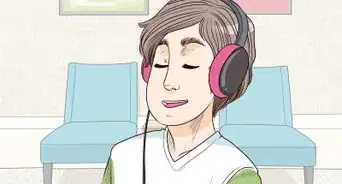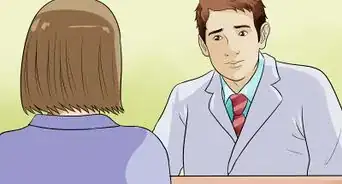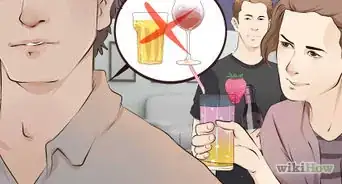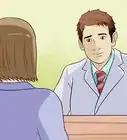This article was co-authored by Trudi Griffin, LPC, MS. Trudi Griffin is a Licensed Professional Counselor in Wisconsin specializing in Addictions and Mental Health. She provides therapy to people who struggle with addictions, mental health, and trauma in community health settings and private practice. She received her MS in Clinical Mental Health Counseling from Marquette University in 2011.
There are 13 references cited in this article, which can be found at the bottom of the page.
This article has been viewed 51,090 times.
It can seem impossible to cope with having post-traumatic stress disorder and still lead a normal life. PTSD may cause you to want to avoid others and isolate yourself from friends and family. You may fear going out into ordinary places and even have anxiety attacks. If you have PTSD, there are ways to manage the symptoms of this disorder and, ultimately, lead a healthy and happy life.
Steps
Getting Professional Help
-
1Get a proper diagnosis. The first step you can take towards fighting your PTSD is to verify that you actually have this mental illness. PTSD is an anxiety disorder and the symptoms can often overlap with other similar conditions.[1]
- See a mental health provider for a thorough differential diagnosis so that you can get the adequate treatment for what's bothering you. In order to receive a diagnosis of PTSD, you must have a history of exposure to a traumatic event that meets specific stipulations.
- For example, you must exhibit symptoms from each of four symptom clusters for a specific period of time: 1) intrusion- nightmares, flashbacks, and recurrent memories; 2) avoidance- avoiding thoughts, people, places, and things that remind you of what happened; 3) negative alterations in cognitions and mood- feeling alienated from others, persistent negative beliefs about the world, inability to recall aspects of the event, etc.; and 4) alterations in arousal and reactivity- irritability, hyperarousal, sleep disturbances, etc.
- Anyone who has experienced a traumatic event can end up with PTSD. Children who suffer from abuse, people who have been sexually assaulted, combat veterans, and car accident or natural disaster survivors are all at risk of developing this disorder.
- Acute Stress Disorder is a related anxiety disorder that can often become PTSD. ASD occurs within one month after the traumatic event. It can last between 3 days and 4 weeks. Acute stress symptoms that last longer than one month are a sign that the disorder has progressed to PTSD.[2]
-
2Talk to a therapist who has experience working with trauma victims. Sure, talking to your parents or close friends can help you process your feelings after a traumatic event, but a therapist is specially trained at helping individuals like you. Tell your therapist everything! Even avoiding details that seem small can make the problem harder to resolve. If you have to cry, then cry.[3]
- Therapists may use cognitive-based treatments that focus on helping you to identify and change your thoughts and beliefs about the horrible event. Survivors often blame themselves for what happened. Talking through the event with a professional can help you to come to terms with how little control you had over what happened.#*Some treatment approaches involve gradual or all-at-once exposure to places or situations that relate to the trauma. One of the diagnostic criteria--avoidance--causes people to refrain from talking about or thinking about the event. However, processing what happened and talking about it with your therapist can help you to heal from the event.
- Your therapist should be open to shifting your treatment plan to the best option for you. Different people heal in different ways, and it's important to choose the treatment option(s) that best fits your situation.
Advertisement -
3See a psychiatrist for medication management. If certain symptoms of your PTSD significantly affect your ability to function, such as not being able to sleep or having so much anxiety that you fear going to work or school, your therapist might refer you to a psychiatrist for pharmacological treatment. Selective serotonin reuptake inhibitors (SSRIs) are the most commonly prescribed medication for PTSD, but other antidepressants, mood stabilizers, and other medications may be helpful. Note that each medication carries its own group of side effects, which you should discuss with your physician.[4]
- Sertraline (Zoloft) helps with amygdala seratonin deficiency by boosting your brain's serotonin production.
- Paroxetine (Paxil) increases the amount of serotonin available to the brain.
- Sertraline and paroxetine are the only medications currently approved by the FDA for treating PTSD. Other medications may be used, but they have not been approved by the FDA for treating PTSD.
- Fluoxetine (Prozac) and Venlafaxine (Effexor) are sometimes used to treat PTSD. Fluoxetine is an SSRI, but venlafaxine is an SNRI (selective serotonin and norepinephrine reuptake inhibitor), meaning it increases both serotonin and norepinephrine.
- Mirtazapine, which affects both seratonin and norepinephrine, may be helpful for treating PTSD.
- Prazosin, which helps decrease nightmares in PTSD, is sometimes used as an "adjunctive" treatment, meaning it is prescribed in addition to other treatments such as an SSRI and therapy.
- Suicidal thoughts may be a side effect of SSRI and SNRI use. Consult with your doctor to understand these risks and how to handle them.
-
4Participate in support groups. If you are having difficulty struggling with the fear and anxiety that accompanies PTSD, it may be helpful to join a support group. While these groups are not directly aimed at treating the disorder, they do help those dealing with symptoms feel less alone and provide them with encouragement from others who are going through the same ordeal[5] .
- Receiving a new diagnosis such as PTSD may be difficult to come to terms with. Taking part in a group helps you to see that there are millions of people out there managing this disorder. Joining a group may help you to reconnect socially.
- If your spouse or loved ones are having trouble coming to terms with your diagnosis, they may be able to gain useful tips and support by participating in a recovery group for partners or family members of those with PTSD.
- The Anxiety and Depression Association of America has a search feature that can help you locate a support group near you.
- If you are a veteran, contact your local VA.
Living with PTSD
-
1Take care of your body and mind. Many people have found that getting adequate exercise, eating a diet of healthy foods, and enough rest can make a significant impact on PTSD. Plus, all of these strategies have been proven effective against battling both stress and anxiety which are naturally high in PTSD-sufferers.[6]
- Changing certain elements in your lifestyle may help reduce symptoms or help you to be able to manage your PTSD symptoms better. When you are getting regular physical activity and eating a diet of whole foods, you may feel better equipped to attack negative thought patterns or come down more quickly from an anxiety attack.
- Avoid alcohol and drugs. Find healthier ways of coping with stress and undesirable feelings like going for a walk outdoors, reading an interesting novel or phoning a friend to talk things over.
- Recognize that having PTSD does not make you weak. Understand that PTSD can affect anyone. In fact, strong people may be the ones who wind up in situations that cause it, either because they stood up for what they believed in, tried to help others, or have survived personal obstacles. If you developed PTSD after military service, you were brave to join and you're still brave now. Facing PTSD and seeking treatment is courage in itself.
-
2Keep a personal journal. Write down anything that bothers you during a day because these situations or object might be triggers for nightmares or flashbacks. Also, write down how you are feeling and whether your symptoms are particularly bad or okay that day.[7]
- This helps you keep track of progress but can also be helpful to your therapist in finding out how your symptoms change from day to day.
-
3Lean on family and friends. Try to refrain from falling into the avoidance trap. While it may seem that staying away from others makes you feel better, it's actually making your symptoms worse. Social support may help to relieve both anxiety and depression related to post-traumatic stress disorder.[8]
- Pay attention to when your symptoms are especially intense and try to plan to spend time with loved ones who make you smile and comfort you.
- You can also find support through peer support groups and connect with others who have or are experiencing PTSD. Find a support group here.
-
4Become a voice for others. When you learn to manage a serious condition like PTSD, it may help you heal even more by helping another person who is going through the same thing. Advocating about mental health policy and access to services may help you feel empowered on your journey of recovery from PTSD.[9]
- Raising awareness for a mental illness that you are affected by helps you and helps others in the process. Advocacy enables you to transform a terrible incident in your life into a positive message for mental health providers, policymakers, and those impacted by mental illness.
Controlling Panic
-
1Recognize the signs of an impending panic attack. Persistent fear is an underlying aspect of having PTSD. Excessive stress or fear can cause panic attacks, and panic attacks often co-occur with PTSD. These may last anywhere from five minutes to an hour or more. Sometimes, you may begin to feel extremely panicky without any obvious signs. Each time you respond in positive ways to your anxiety or panic, you will be working toward making it happen less often. Practice will make it easier to cope. Common signs of a panic attack include:[10]
- Pain in your chest
- Difficulty breathing or feeling short of breath
- Sweating
- Choking sensations
- Trembling or shaking
- Nausea
- Dizziness, light-headedness or faintness
- Chills or feeling hot
- Numbness or tingling
- Derealization (feelings like you're not real) or depersonalization (feeling like you're outside yourself)
- Fear of losing control or "going nuts"
- Fear of dying
- A general sense of doom
-
2Practice deep breathing. This technique can be useful in reducing anxiety, fear, and even bothersome aches and pains. The mind, body and breath are all interrelated, so taking a few minutes to engage in purposeful breathing can offer a wide range of benefits such as lowering the blood pressure, relaxing the muscles, and increasing energy levels.[11]
- Typical deep breathing consists of inhaling for 5 to 8 counts, briefly holding the breath, and then exhaling for 5 to 8 counts. This serves to help transform you into a calmer state.
-
3Try progressive muscle relaxation. Another technique found to be effective at reducing anxiety involves a gradual and systematic tightening and releasing of each muscle group. This method can ease stress and help with conditions beyond anxiety like insomnia and chronic pain. Progressive muscle relaxation also makes use of deep breathing for even greater impact.
- Start at the tips of your feet and slowly move up through the body. While inhaling for 5 to 10 counts, contract the muscles of the feet, and hold. As you exhale, suddenly release the tension of those muscles, taking notice of how they feel after the tension has been let go.
-
4Meditate. This relaxation technique might be difficult to engage in if you're in the middle of a full-blown panic attack. However, meditation can be quite helpful at preventing these attacks from occurring in the first place.[12]
- If you're a beginner, start small with about 5 minutes per day and progressively sit for longer periods. Select a quiet, comfortable environment with minimal distractions. Sit on the floor or a cushion with your legs crossed, or on a comfortable chair with your back straight. Close your eyes and began taking slow, deep breaths, in through your nose and out through your mouth. Focus only on the action of breathing, bringing your attention back here whenever your mind goes astray. Continue this exercise for as long as you'd like.
- A study of 16 participants in a mindfulness-based stress reduction program engaged in an average of 27 minutes of meditation each day. At the end of the study, MRIs showed changes in the participant's brain structures, revealing an increase in compassion, self-awareness and introspection and a decrease in anxiety and stress.[13]
-
5Try to minimize worrying. Constant worrying about when a panic attack will happen may actually cause it to happen. Keep yourself busy and distracted so that you do not accidentally start up excess anxiety due to nonstop worrying.
- Develop a few positive self-talk strategies for when you find yourself worrying over and over again. These can be telling yourself "I will be ok." or "This, too, shall pass." Reminding yourself that you have been here before and survived can make anxiety attacks less frightening and possibly even prevent them.
- When you find yourself worrying about the future, try to focus your attention back on the present. Write down some things you are grateful for or some positive attributes about yourself such as "I am strong." This can assist you in getting a grasp on anxiety and remind you that your life isn't all bad which can feed panic.
Expert Q&A
-
QuestionHow does PTSD in parents affect children?
 John A. Lundin, PsyDJohn Lundin, Psy. D. is a clinical psychologist with 20 years experience treating mental health issues. Dr. Lundin specializes in treating anxiety and mood issues in people of all ages. He received his Doctorate in Clinical Psychology from the Wright Institute, and he practices in San Francisco and Oakland in California's Bay Area.
John A. Lundin, PsyDJohn Lundin, Psy. D. is a clinical psychologist with 20 years experience treating mental health issues. Dr. Lundin specializes in treating anxiety and mood issues in people of all ages. He received his Doctorate in Clinical Psychology from the Wright Institute, and he practices in San Francisco and Oakland in California's Bay Area.
Clinical Psychologist Kids are like emotional sponges, so they will often have a direct sense of their parent’s PTSD symptoms. That's why it is so important for parents to take their recovery seriously and seek the help of a qualified professional. Kids can experience similar symptoms to PTSD if they are exposed often enough to the more overt symptoms in parents, such as panic attacks. It is important to be aware of how a parent’s anxiety is affecting a child in their care. It is important to reassure them that things will be okay, and seek treatment for them if their own suffering persists.
Kids are like emotional sponges, so they will often have a direct sense of their parent’s PTSD symptoms. That's why it is so important for parents to take their recovery seriously and seek the help of a qualified professional. Kids can experience similar symptoms to PTSD if they are exposed often enough to the more overt symptoms in parents, such as panic attacks. It is important to be aware of how a parent’s anxiety is affecting a child in their care. It is important to reassure them that things will be okay, and seek treatment for them if their own suffering persists. -
QuestionDo I need to tell my boss?
 Allison Broennimann, PhDDr. Allison Broennimann is a licensed Clinical Psychologist with a private practice based in the San Francisco Bay Area providing psychotherapy and neuropsychology services. With over a decade of experience, Dr. Broennimann specializes in in-depth psychotherapy to provide solution-focused treatments for anxiety, depression, relationship problems, grief, adjustment problems, traumatic stress, and phase-of-life transitions. And as part of her neuropsychology practice, she integrates depth psychotherapy and cognitive rehabilitation for those recovering after traumatic brain injury. Dr. Broennimann holds a BA in Psychology from the University of California, Santa Cruz, and an MS and Ph.D. in Clinical Psychology from Palo Alto University. She is licensed by the California Board of Psychology and is a member of the American Psychological Association.
Allison Broennimann, PhDDr. Allison Broennimann is a licensed Clinical Psychologist with a private practice based in the San Francisco Bay Area providing psychotherapy and neuropsychology services. With over a decade of experience, Dr. Broennimann specializes in in-depth psychotherapy to provide solution-focused treatments for anxiety, depression, relationship problems, grief, adjustment problems, traumatic stress, and phase-of-life transitions. And as part of her neuropsychology practice, she integrates depth psychotherapy and cognitive rehabilitation for those recovering after traumatic brain injury. Dr. Broennimann holds a BA in Psychology from the University of California, Santa Cruz, and an MS and Ph.D. in Clinical Psychology from Palo Alto University. She is licensed by the California Board of Psychology and is a member of the American Psychological Association.
Clinical Psychologist It really depends on the severity of your PTSD. If it feels safe, consider at least telling HR. That way, if you ask for accommodations down the line, there's a record of it.
It really depends on the severity of your PTSD. If it feels safe, consider at least telling HR. That way, if you ask for accommodations down the line, there's a record of it. -
QuestionHow can I deal with depression caused by my PTSD?
 Allison Broennimann, PhDDr. Allison Broennimann is a licensed Clinical Psychologist with a private practice based in the San Francisco Bay Area providing psychotherapy and neuropsychology services. With over a decade of experience, Dr. Broennimann specializes in in-depth psychotherapy to provide solution-focused treatments for anxiety, depression, relationship problems, grief, adjustment problems, traumatic stress, and phase-of-life transitions. And as part of her neuropsychology practice, she integrates depth psychotherapy and cognitive rehabilitation for those recovering after traumatic brain injury. Dr. Broennimann holds a BA in Psychology from the University of California, Santa Cruz, and an MS and Ph.D. in Clinical Psychology from Palo Alto University. She is licensed by the California Board of Psychology and is a member of the American Psychological Association.
Allison Broennimann, PhDDr. Allison Broennimann is a licensed Clinical Psychologist with a private practice based in the San Francisco Bay Area providing psychotherapy and neuropsychology services. With over a decade of experience, Dr. Broennimann specializes in in-depth psychotherapy to provide solution-focused treatments for anxiety, depression, relationship problems, grief, adjustment problems, traumatic stress, and phase-of-life transitions. And as part of her neuropsychology practice, she integrates depth psychotherapy and cognitive rehabilitation for those recovering after traumatic brain injury. Dr. Broennimann holds a BA in Psychology from the University of California, Santa Cruz, and an MS and Ph.D. in Clinical Psychology from Palo Alto University. She is licensed by the California Board of Psychology and is a member of the American Psychological Association.
Clinical Psychologist I think, as a parent, be aware that sometimes a traumatic event will happen. And there might be some sort of depressive episode following it. Be prepared and willing to ask for help from friends and family or your partner in case a depressive episode occurs afterward. That's a normal process for most people. And then, ideally, get a therapist immediately. The longer you go without working through the trauma, the more damaging it's going to be. And it may not be accessible without help.
I think, as a parent, be aware that sometimes a traumatic event will happen. And there might be some sort of depressive episode following it. Be prepared and willing to ask for help from friends and family or your partner in case a depressive episode occurs afterward. That's a normal process for most people. And then, ideally, get a therapist immediately. The longer you go without working through the trauma, the more damaging it's going to be. And it may not be accessible without help.
Warnings
- Individuals with PTSD may have scary thoughts, feel depressed, or think of suicide or homicide. Call a hotline or contact your local doctor if you have any thoughts that make you want to end your life or the life of someone else.⧼thumbs_response⧽
References
- ↑ https://www.nhs.uk/mental-health/conditions/post-traumatic-stress-disorder-ptsd/overview/
- ↑ http://psychcentral.com/disorders/acute-stress-disorder-symptoms/
- ↑ https://www.nhs.uk/mental-health/conditions/post-traumatic-stress-disorder-ptsd/treatment/
- ↑ https://www.ptsd.va.gov/understand_tx/meds_for_ptsd.asp
- ↑ https://www.nami.org/About-Mental-Illness/Mental-Health-Conditions/Posttraumatic-Stress-Disorder/Support
- ↑ http://www.takingcharge.csh.umn.edu/manage-health-conditions/anxiety-depression/what-lifestyle-changes-are-recommended-anxiety-and-depre
- ↑ https://www.health.harvard.edu/healthbeat/writing-about-emotions-may-ease-stress-and-trauma
- ↑ https://www.nimh.nih.gov/health/topics/post-traumatic-stress-disorder-ptsd#part_2241
- ↑ https://www.mind.org.uk/information-support/guides-to-support-and-services/advocacy/what-is-advocacy/#.VdtDG7JViko
- ↑ http://www.adaa.org/understanding-anxiety/panic-disorder-agoraphobia/symptoms
- ↑ https://www.takingcharge.csh.umn.edu/learn-relaxation-techniques
- ↑ https://www.helpguide.org/articles/ptsd-trauma/ptsd-symptoms-self-help-treatment.htm
- ↑ http://www.health.harvard.edu/blog/mindfulness-meditation-may-ease-anxiety-mental-stress-201401086967
-Step-1.webp)
-Step-2.webp)
-Step-3.webp)
-Step-4.webp)
-Step-5.webp)
-Step-6.webp)
-Step-7.webp)
-Step-8.webp)
-Step-9.webp)
-Step-10.webp)
-Step-11.webp)
-Step-12.webp)
-Step-13.webp)






















































Medical Disclaimer
The content of this article is not intended to be a substitute for professional medical advice, examination, diagnosis, or treatment. You should always contact your doctor or other qualified healthcare professional before starting, changing, or stopping any kind of health treatment.
Read More...